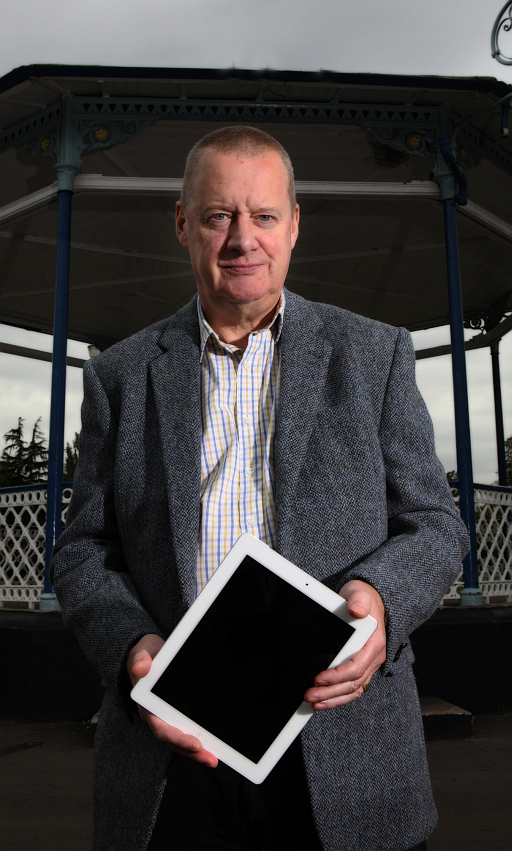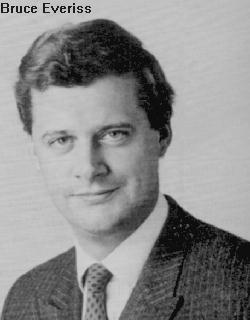![]() |
| Bruce Everiss with the Kwalee team | |
|
|
|
|
In the early 1970s I trained as an accountant in Liverpool, because of wanting to be a businessman. There wasn’t the plethora of business degrees then so serving articles for the Institute of Chartered Accountants seemed to be the best way of gaining a broad business-based knowledge. After this I became a Managing Director, running a computerised book-keeing company called
Datapool Services, which is still going! In those days the only computers were vast and enormously expensive machines owned by government, universities and big business. So our book-keeping was done on time rented from a big bank computer.
During this time I started reading the two computer industry newspapers,
Computer Weekly and
Computing. Occasionally they carried articles about the amazing idea that an individual person could own a computer and have it at home, using a kit of electronic parts centred around the only recently available microprocessors. Then came news of people actually setting up retail stores to look after the people who were interested in these products. I knew that this would explode in popularity and decided to do the same. I begged, borrowed and stole the money to set up
Microdigital in Liverpool in 1978, one of the first computer stores in Europe. Most British people couldn’t afford the expensive American home computers, but luckily we had a home grown device called the Nascom 1, which cost £200. This was a kit with 1,200 solder joints and which gave users a massive 1K of RAM to play with. We created a very successful business fixing kits that people had built but which had failed to work.
For rich people we sold the
Apple 2, which had 16K of RAM for £1,200. This was a fortune in those days and used a cassette interface to input and output content. Eventually Apple brought out a disk drive that cost £425 and which had a capacity of 113K. Everybody thought that this was incredible.
Over the years we sold many other machines: the
Commodore Pet, the
Science of Cambridge MK14 (from Uncle Clive),
Exidy Sorcerer,
Hewlett Packard HP-85,
Sharp MZ 80K and more.
Getting hold of stock to sell was problematic, as the demand was so much greater than the industry could possibly keep up with. It was not unusual for our turnover to double month on month. Our bread and butter was selling books, which we imported from America, to satisfy the thirst for knowledge. We set up a mail order department and pretty soon we were shipping stuff all over the world. We also set up our own monthly computer hobbyist magazine called
Liverpool Software Gazette and used our extensive contacts to fill it with excellent articles.
During this time I went to America a lot, they were well ahead of us and were the place where the products and ideas were coming from. On one visit to Apple in Cupertino, California, I was offered their UK distributorship but turned it down because I knew we just couldn’t handle it. On these trips I also visited the early computer stores, such as
Computer Components of Orange County. I noticed they had some polythene bags attached to a noticeboard containing a cassette (or disk) and a sheet of photocopied paper in each one. These were the very first commercially available home computer video games that people had written and duplicated at home to sell on the noticeboard. I bought loads of them and brought them back to use as demonstration software in the shop.
Eventually I sold
Microdigital out to a large chain of Hi Fi retailers called
Laskys for them to use us as a template to put computer stores within their shops all over the country. Then there was a phase of consulting. I did the business plan for a home computer industry magazine for Felix Dennis at
Dennis Publishing, this became
Microscope. I did a pile of stuff for an office equipment company in Liverpool called
DAMS and I did some work for
Bug Byte. This was fascinating, one of the very first home computer game publishers in Britain. I managed to convince them to upgrade their cassette inlay cards from crude mono sheets, sometimes photocopied, that were the industry standard, to professional four colour printed cards with an airbrush image to represent the game.
Then, in 1982, one of my former Microdigital Employees who worked at Bug Byte, Mark Butler, told me he was setting up his own company with a programmer he worked with called David Lawson. I joined them as Operations Director at
Imagine Software and took over marketing, amongst other things. Then Eugene Evans joined us who had been a Saturday boy in the Microdigital shop before working for Bug Byte. Eugene is now VP, Studio GM,
Bioware Mythic, at
Electronic Arts. Back then there was no proper video game industry. Most people who wrote games ran their business from home (often part time) and sold directly to customers by mail order. We decided to do it differently with a proper company with departments and offices. Our first problem was getting sales. I remember sitting with everyone else on the carpets, packaging up games to go in the mail and then filling rows of mailbags up. This was no way to go. So I recruited a couple of tele-sales staff from DAMS (something that was then new and which I had learned there). They were given every Yellow Pages for the UK and they rang retailers telling them to stock our games. This was the foundation of video games as an industry in the UK. They would ring every newsagent, then every electronics shop, then every photographic retailer, doubling turnover every month. Obviously once a retailer started selling games they would look for more to sell and would contact our competitors. So the industry moved from a mail order hobbyist footing to professionally run companies selling their products at retail.
After a while I recruited two more tele-sales staff. One who spoke French and German fluently and one who spoke Spanish and Italian fluently. Then we sold our stuff like crazy all across Europe. This was the beginning of the dominance of the British video game publishers in Europe. At the same time we developed our inlay cards adding more and more folds and on these we put development credits, company profile, sales material for our other games and translations for our overseas customers.
Games originally were written by one person using assembler software and writing on the target machine. The first improvement was when John Gibson was having difficulty getting the clouds to look realistic in
Zzoom. We dragged an artist in and using a piece of graph paper he represented pixels and created realistic clouds. David Lawson seized on this and soon we were employing artists, then he extended the concept and we were employing musicians. Then we looked at getting away from using the target machines and bought very powerful 68000 based professional computers running Z80 assemblers. Then we started to move over to the C programming language.
So throughout the life of Imagine software we continued to lead and innovate in many ways. What we did was very widely copied. The reason we had to be creative was because nothing existed before us, we were the pioneers in many ways.



























































